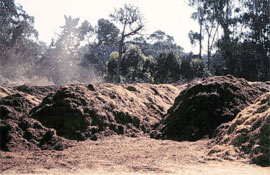Where are the enterococci coming from?
Here’s another fun fact. There are about 10 million enterococci in every gram of human feces.
Let’s assume that this number is representative of other vertebrates as well. So how many kilos of feces would be needed to put 20 million trillion enterococci into the Bay?
How much poop is that already? |
|
|---|---|
| 20 million trillion divided by 10 million is... | |
| Or in kilograms... | |
| Or in tons (2000 kilos)... | |
According to Tom Horton in Turning the Tide, about 44 million tons of manure are produced in the Chesapeake Bay watershed every year -- 100+ pounds per day per cow, 20 pounds per pig and another 4 oz per day per chicken. So, again, its not too far fetched to think that 1 million tons of that ends up in the water.
Of course, manure doesn’t get dumped directly into the water, not legally at least. But today’s industrial farming operations make large amounts of manure unavoidable. Typical farms in the late 1990s had about 60 cows, 300 hogs, or upwards of 100,000 chickens, concentrated on relatively small acreages. Where does all this manure go? Some of it can be spread on fields, but in cold or rainy weather, that creates more runoff. Storage pits, or lagoons, can hold manure until it can be spread, but these lagoons are also vulnerable to leakage or overflow.
 |
 |
 |
|---|
Copyright University of Maryland, 2007
You may link to this site for educational purposes.
Please do not copy without permission
requests/questions/feedback email: mathbench@umd.edu
